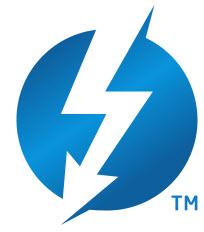Why Thunderbolt will never make it mainstream


However, this won't solve the biggest problem facing the interface: it's far too niche a technology to ever enter the mainstream market.
From a technological perspective, there's a lot to like about Thunderbolt. The interface combines both PCIe and DisplayPort traffic into a single cable, and it supports a transfer rate of up to 20Gbps per channel (10Gbps uplink, 10Gbps downlink). It allows external devices such as monitors to support DisplayPort, Gigabit Ethernet, FireWire 800, audio and USB, without needing a plethora of cabling between the monitor and PC.
One cable can do it all.
But as great as Thunderbolt is, almost every usage scenario for the interface is niche, and that dooms it from every going mainstream.
Take Apple's 27-inch Thunderbolt display. Here you have a LED-backlit display panel with integrated Gigabit Ethernet, audio, FaceTime HD camera, USB, and FireWire controllers. You can connect this panel to any Thunderbolt-enabled Mac and have access to all the built-in functionality via a single cable. Also, because Thunderbolt devices can be daisy-chain, the display can be part of a string of Thunderbolt devices attached to a system.
The Apple Thunderbolt display is an awesome piece of technology, but it should be for $999. It may be no more expensive than the non-Thunderbolt version, but the market for $999 LCD panels is small.
Another use for Thunderbolt is as an interface for high-speed external storage devices. A six-bay storage unit such as the Promise Pegasus R6 boasts a transfer rate of up to 800 MB/s. That's a blisteringly fast transfer rate, but one that few people outside of professionals carrying out high-end video editing or 3D modeling actually need.
These external storage units are also very expensive. Expect to pay more than $1,600 for a Pegasus R6 with 6TB of storage, with the 12TB model going for in excess of $2,400.
Hardware to plug into your Thunderbolt port
| Image Gallery: Hardware to plug into your Thunderbolt port | ||||||
Yes, that's as niche as it sounds.
Another use for Thunderbolt is to connect portables to docking stations. For example, an ultrabook could be connected to a dock via Thunderbolt using a single connector. The dock could feature additional interfaces, such as Ethernet and USB, and could have a more powerful GPU installed, turning the ultrabook into a desktop system.
Docks are a great idea, and they've been around for some time. Problem is, they don't sell that well --- partly because people don't feel they need them, and partly because vendors charge a premium price for them.
Again, another niche market.
Thunderbolt suffers from the same problem as faced by the FireWire interface, in that it's a premium product that offers performance that goes way beyond what most people want or need -- or certainly more than they are willing to pay for. FireWire 400 was far superior to USB, but it was USB that became the mainstream standard, mostly because it was cheaper, in terms of both the interface itself and the devices. FireWire 800 was far superior to USB 2.0, but it was USB 2.0 that went mainstream, mostly down to cost factors. Thunderbolt is far superior to USB 3.0, but it will be USB 3.0 that goes mainstream, again, down mostly to cost.
Being better than other technology is only part of the equation. If that technology has a chance of going mainstream, not only does it have to be better than an existing solution, it has to be cheaper too.
Thunderbolt may be better than another other interface currently available, but the premium price will prevent it from ever going mainstream. Cost factors not only weigh on the minds of consumers, but also cool manufacturer's interest in supporting the interface.
Image source: Intel.
Related: